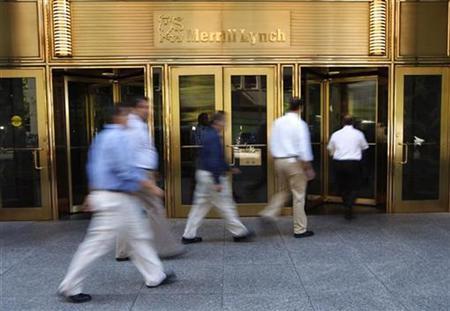(Reuters) – At least 50 advisers who managed nearly $12 billion in client assets at Merrill Lynch have left the “thundering herd” since January 1, based on moves tracked by Reuters.

Many were veteran brokers that are hard to replace and who managed large sums of client assets at the firm. Reuters tracks the movement of advisers and teams managing a minimum of about $100 million in client assets. Such advisers or teams typically generate $1 million or more in revenue annually.
Merrill dismissed the defections.
“People have been calling ‘the great exodus’ for more than a decade now and the facts have not borne it out,” the firm said in a statement Monday. Merrill, which was purchased by Bank of America in 2009, declined to comment further about the recent departures.
But data collected by Reuters tells a different story. At least 70 advisers who managed more than $16 billion in client assets have left the firm since September, among advisers or teams managing $100 million or more. That accounts for more than 1 percent of the brokerage’s roughly $1.5 trillion client asset base.
While the company has in the past said that departures are of little concern because Merrill has a robust training program, industry observers say it can take trainees 10 to 20 years to amass $100 million in client assets.
“Even a couple of big teams leaving can rip a big hole because they are just so substantial,” said Alois Pirker, a research director at the Boston-based Aite Group, which studies wealth management trends. “When you’re losing advisers and have to replace them and pay big signing bonuses, it’s an expensive proposition.”
The defection of Merrill brokers is happening across the country, from a Fifth Avenue Merrill office in New York, to a New Orleans complex in Louisiana and a Beverly Hills branch in California. Many are longtime Merrill brokers, including one who had worked for the firm at the same desk for 45 years.
“Some of the senior talent is going to take a while to replace,” said former Merrill adviser Brad Stratton, who left the firm three weeks ago after 20 years. The departure of big names often leads other advisers at the branch office to consider similar moves, he said.
“When a senior producer leaves, (he is) usually not the last one to go,” he said.
Some advisers who left in late February and early March did so after the arrival of a final stock award – the last of its kind tied to a guaranteed share price of around $52 in 2002 – delivered on Feb 15. Some senior Merrill advisers have also been riled by the pressure they say they are under to cross-sell Bank of America loans and services, which has led some to leave.
COMPETITIVE LOSSES
Attrition in the wealth management business is usually met with a healthy inflow of adviser recruits back into the firm. Morgan Stanley Smith Barney, UBS and Wells Fargo – home to the three other largest U.S. brokerages – have all lost advisers, but also added top producers to match the client assets they lost.
For instance, UBS has lost advisers who managed at least $644 million in client assets in 2012, but gained advisers who managed more than $4 billion in client assets over the same period. Wells Fargo and Morgan Stanley Smith Barney lost advisers who managed roughly $767 million and $3.2 billion, respectively, but recruited advisers who managed $2.2 billion and $3.3 billion, respectively.
But so far in 2012, Merrill has not announced any big teams to fill the gaps left by those who have departed. The company declined to comment when asked about recruits from rivals.
“They’re typically good at recruiting, but now it’s more of a one-way street,” said Tom Lewis, a New Jersey-based lawyer with Stark & Stark. Lewis has helped transition about 400 Merrill advisers to other firms over the past 15 years. He has worked with 25 to 30 departing Merrill advisers in the last three months alone – more than any other period in his career.
Most recent among them: 20-year Merrill veteran Peter Sargent, who managed $250 million in client assets and generated $2 million in annual revenue, in Yardley, Pennsylvania.
Competing firms are wooing top Merrill brokers with lucrative recruiting packages that include upfront signing bonuses and other compensation for meeting revenue targets.
As recently as last month, UBS offered top advisers up to 350 percent of their annual production in up-front and back-end portions combined, said Lewis. The standard is 200 percent.
“It’s the highest I’ve seen it by far,” Lewis said. “I don’t recall ever a time when it reached that level.”
UBS has been the most successful of the big brokerages in hiring Merrill advisers. More than half the veteran advisers UBS added in 2012 – 22 brokers, managing $3 billion in client assets – came from Merrill. Morgan Stanley Smith Barney in 2012 has wooed eight Merrill advisers managing more than $2.7 billion.
Merrill Lynch increased its recruiting packages for top producers last month, offering an upfront cash payment of 150 percent of the fees and commissions top advisers generated during the prior 12 months. It is unclear if the packages have helped recruit advisers.
FUTURE CONCERNS
In its latest annual regulatory filing, Merrill expressed concerns about retaining top wealth advisers, alluding that further defections could begin to weigh on the bottom line for Merrill.
In a February 24 filing the company expressed concern about failure to retain wealth advisers, “particularly those with significant client relationships.” The filing said, in part, that “such failure could result in a significant loss of clients or withdrawal of significant client assets,” which could adversely impact its finances. It was the second year in a row that the company took the unusual step of highlighting concerns about defections.
It can be hard to gauge how much in client assets move with an adviser who defects. But it is generally a large percentage.
Big-firm brokers who leave for another large competitor firm bring about 70 to 85 percent of clients with them, said California-based financial services recruiter Ron Edde. Longtime advisers often bring up to 90 percent of client assets.
Most of the brokers leaving Merrill in the last six months were legacy advisers with deep client relationships.
Memphis-based banking analyst Marty Mosby of Guggenheim Partners said will be important to see “how long” and “how deep” those defections last, especially over the next six months to a year. He said some loss was expected because of the capital constraints the bank has faced after the 2008 financial crisis.
“A couple of quarters is one thing, two years is another,” Mosby said.
(Reporting By Ashley Lau; Editing by Jennifer Merritt and Tim Dobbyn)


